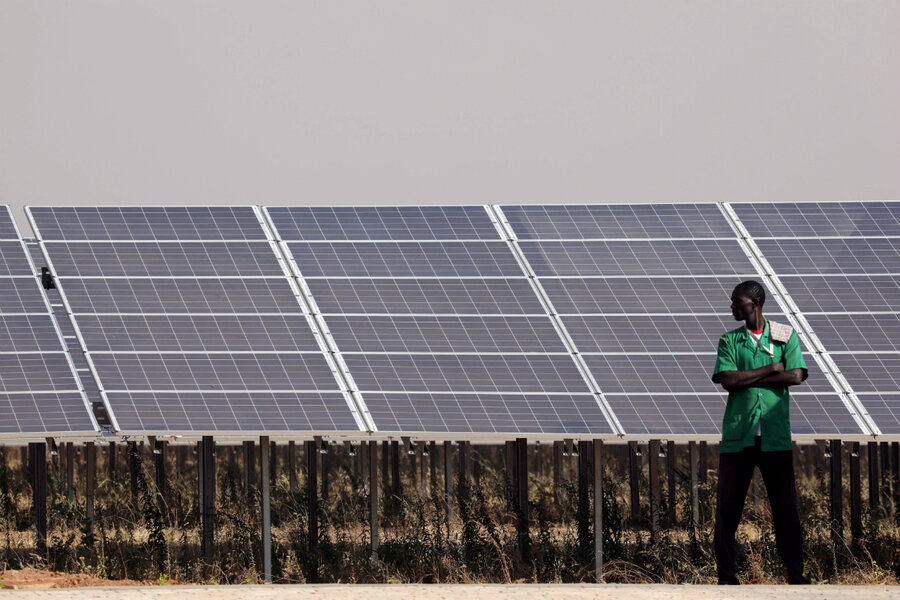As clean energy prices fall, rural communities in Asia, Africa benefit
| Abu Dhabi, United Arab Emirates
With the costs of creating electricity from solar power and wind continuing to fall, electricity from renewable energy will soon be “consistently cheaper” than electricity from fossil fuels, according to the head of the world’s renewable energy agency.
By 2020, most wind and solar power technology now being commercially used will be priced in the same range as fossil fuels, “with most at the lower end or even undercutting fossil fuels,” said Adnan Amin, the director general of the International Renewable Energy Agency (IRENA).
That is particularly good news for communities in parts of Africa, Asia, and other parts of the world that remain unconnected to power grids and without access to modern energy, experts said.
Cheaper prices for improved technology, combined with new financial arrangements to help put it in place, should lead to more unconnected communities getting access to clean power, according to energy access body Power for All.
“The falling cost of solar and an expected decline in [costs of renewable energy] storage are providing a major boost to delivering electricity and related services to communities without access to energy,” William Brent, a spokesman for the organization, told the Thomson Reuters Foundation.
“But it's not just a question of solar technology, which has achieved full commercial viability and is now cheaper than coal in many countries. Many companies are also pioneering delivery methods using innovative business and financial models, as well as through advances in super-efficient appliances,” he added.
Decentralized solar systems, including mini-grids and home systems, are expected to serve up to 100 million households by the year 2020, he said.
Rwanda, for example is taking advantage of dropping costs to outfit 500,000 homes with solar systems, which should enable nearly 2 million people to access clean electricity before the end of 2019, said James Musoni, Rwanda’s minister for infrastructure, including electricity.
“With renewable power alternatives becoming consistently affordable each day, it is upon us to take advantage of this and ensure that we move even closer to achieving universal access to electricity,” the minister told the Thomson Reuters in an interview.
The program will cost $15 million – money received as a concessional loan from the Abu Dhabi Fund for Development, the minister said.
The cost of producing renewable energy has fallen consistently since 2010, with wind and solar panels leading the way – and in some cases falling in price by as much as 73 percent over that period, according to a new report by IRENA.
The biggest price drops have come in the cost of generating utility-scale power from solar panels, which means that such energy can now be added at a much more competitive cost, Mr. Amin said.
In 2016 alone, he said, more than 160 gigawatts of renewable energy capacity was added to the world energy mix, or a nearly 9 percent increase.
Around 70 percent of that increase came in developing countries, with Asia account for 58 percent and Africa 12 percent, he said.
Technological advances, competitive procurement, and a large base of experienced, internationally active project developers were the main drivers of the lower costs, Amin said.
The agency said its 2017 review of the industry showed the renewable energy sector supported 9.8 million jobs globally, with solar voltaic systems the largest employer with 3 million jobs worldwide. That was a 12 percent increase from the agency’s 2016 review, it said.
Technological innovations and new business models are expected to further reduce the costs of producing electricity from renewable mini-grids by more than 60 percent in the next two decades, the IRENA report said.
“These are transformational developments that are changing the economic models and social patterns of the past,” observed Amin.
Mr. Brent said evolving renewable energy technology meant clean electricity could now power not just lighting in homes but everything from farms to urban businesses.
“It is time for decisionmakers to fully embrace the transformative power of decentralized solutions – rooftop solar and renewable mini-grids in particular – to improve the delivery of education, healthcare, clean water, irrigation, and the many other benefits,” he said.
“We're already seeing decentralized solar providing much more than just light, including replacing diesel to power solar water pumps for irrigation and telecom towers,” he said.
What’s lagging in getting ever cheaper renewable energy used more widely, he said, is often the political support or policy changes needed to speed up the energy transition that world leaders have promised to make as part of the Paris agreement to limit climate change.
However, he said that generating and distributing solar power, in particular, could be a huge new source of jobs, giving communities – particularly poor rural ones – new economic opportunities.
Many countries – such as Tanzania, Kenya, Rwanda, and Mauritius – are already taking advantage of cost reductions to scale-up solar on a commercial basis, including in rural areas, Brent said.
But to achieve universal access to electricity rapidly, governments and business need to take advantage of all available sources of finance, both public and private, he said.
This story was reported by the Thomson Reuters Foundation.





